
JULIA LEE BARCLAY-MORTON – YOGA, WATER AND REWRITING AUTISM
I interviewed writer Julia Lee Barclay-Morton about her experience of autism. Julia began as an experimental dramatist in New York, moving to the UK to
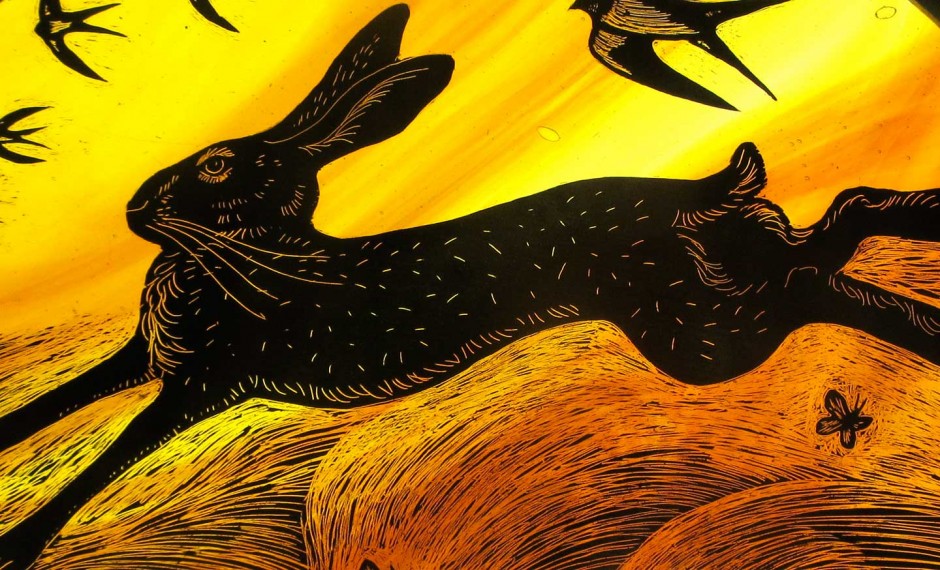
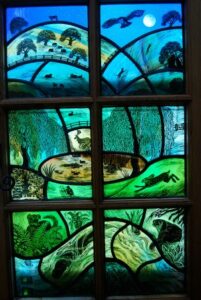
I interviewed Tamsin Abbott who has been producing innovative stained glass for the last 20 years, as featured on BBC TV’s Countryfile and in Country Living magazine. To reach her current level of expertise, Tamsin studied stained glass and illustration for several years. She then invested in a kiln and studio at her rural Herefordshire home, where she still lives and works with her husband and chair-maker, Mike.
Leslie: As a stained-glass artist and illustrator, can you describe your themes, influences and inspirations, please?
Tamsin: As a child I was always torn between words and pictures and imagined that one day I would write and illustrate my own books. After A levels I completed a degree in English Studies, specialising in medieval literature and immersed myself in the enchanted land of chivalric romance. However, every time I tried to write fiction I found that my words were all about summing up an image or a moment in time but I was unable to actually create the complex threads of a continuous story. I abandoned writing and tried to work out my creativity in paint but it was only when I discovered the medium of glass in my early thirties that these images began to present themselves more clearly as visual vignettes or moments in a story that the viewer could embellish for themselves.
I have always been influenced (and almost obsessed) by nature but most specifically animals, continuously drawing and painting them; for a long time I dreamed of speaking with them, and of being absorbed into their world in a way that seemed more natural to me than this human community. I don’t think I am alone in this as I find that this animal ‘spirit’ speaks directly to others too. However, I am also inherently inspired by the idea of myth and legend as well as fairytale and medieval romances, and the sense that our ancestors, who inhabited this land, have left an imprint on it throughout the ages. I also love the idea of the timelessness of the cosmos that overarches everything now as it would have done since time before humanity. It is the intermeshing of all these things that contribute towards my internal universe which I hope manifests in my work.
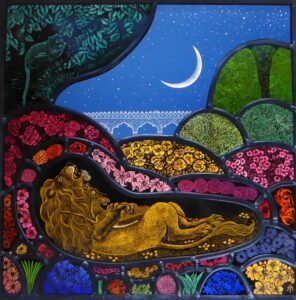
Behind all this inspiration the underlying sense of what I am trying to portray is how much life goes on around us constantly but outside our awareness. Be it a shrew foraging for its young in the hedgerow as we walk by, or a giant spirit dragon that soars above us in the night sky. Conversely, I also wish to capture a sense of the magic of the everyday in my work; the sacred washing line, the reverential bonfire, the glory of a scrap of garden.
Leslie: How has your upbringing and education prepared you for the creative & imaginative work you do now?
Tamsin: I was extremely fortunate to grow up in a loving home where reading, drawing, painting, walking and camping holidays were our major pastimes when not at school. My father was a vicar and my mother a teacher, and in my pre-school years I would often accompany Dad on visits or church business; I saw into many people’s homes and was as enamoured with the trinkets and ornaments people kept on their mantle-pieces as with the magnificence of visiting a cathedral or castle.
However, growing up we also had a certain amount of freedom or beneficent neglect; first in Liverpool and then Derby we were able to roam and always found scraps of land to play on that were less industrial or suburban than at first seemed. Still, my ambition was always to live in the countryside. The means by which I got there was almost irrelevant but I immersed myself in book after book about rural children and country life in the hope that one day it would be my life which it is.
Leslie: There is a very exact production process with the glass you use. Can you describe it, please?
Tamsin: The majority of the glass I use is made by a company called English Antique Glass based in the West Midlands. It is mouth-blown sheet glass, which is full of beauty and alchemy. I cut the glass to shape and then use a variety of processes to ‘paint’ it. The most common of these processes for me is to matt the whole surface over with a black ‘trace’ paint or glaze. I then work into the surface with a variety of tools sgraffito style. I work on a light box and the image gradually transfers itself from my head to the glass as I scratch away. It is similar to an activity we undertook as children where we would colour a sheet of paper in multi-coloured wax crayon then cover the whole surface again with black crayon. We would then scratch off the black with the end of a paintbrush or pencil to create an image.
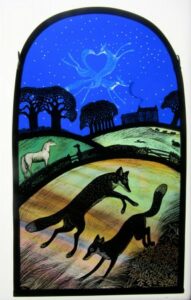
When I started working in glass, I was much more influenced by the work of wood engravers and took hardly any interest in stained glass. As far as I was aware there wasn’t anyone else working in the same way as me at that time and I had a great deal of freedom to create my own ‘wood engraved,’ animal-icon style of free hanging glass panels.
At other times I use the paint like ink. It is an intriguing process as the glass is not absorbent like paper so it is quite a lively and sometimes frustrating process but it is possible to create some wonderful textures and much more depth.
With both of these methods the trace paint needs to be fired into the glass at a temperature of around 660 degrees centigrade. It is possible to build the image up in layers by firing it in various stages but I quite like the challenge of limiting myself to one or two firings only.
The third method of embellishment I use is engraving. Some special glasses are ‘flashed’ that is it only has a very fine layer of colour on one side. Thus, by removing that surface colour one can reveal the main colour underneath which is usually clear or ‘white’. There are various ways to do this but I only do it by using a dremel and engraving the surface colour off.
Leslie: When you come to work the glass yourself, can you describe the demands of the physical process, please, together with the artistic & imaginative work that goes into your creation at the same time?
Tamsin: Working with glass in this way is very different to painting on paper or canvas, in that your palette is all about the stock of glass that you have to hand. When putting together an intricate piece made up of many individual pieces it can take hours of trial and error sifting through my stocks (stored by colour) to find the right matches. However, inspiration often comes directly from the glass itself. A particular sheet or offcut will sing out to me; describing to me a particular season or time of day and I will then use that as the starting point for my design. At this point there is a lot of physicality in the process, pacing back and forth, holding pieces to the natural light or the lightbox, all day moving between my work stations and shelves and then the cutting itself which must be done standing up. But once I begin to paint, I am sitting and it is this which is probably worse for my body!
The important but rather secondary processes of joining the fired glass with lead, soldering and cementing, is something which I find very tiring now. I have been doing this for nearly 20 years and for a long time I didn’t even think of it as physical. However, now I’m in my mid-fifties I notice the things that take their toll physically and it is particularly my thumb joints, which are already becoming very painful and losing their strength. I also have back and neck problems and my hips are not too happy if I have to stand all day!
Leslie: Can you describe some seminal or breakthrough examples of your stain glass work please.
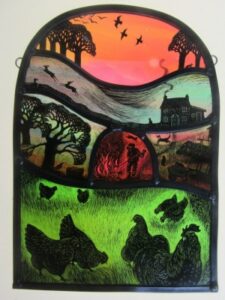
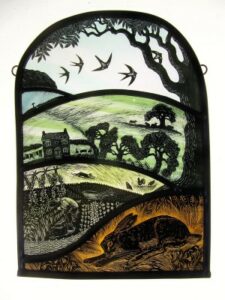
Tamsin: For years I worked with very similar patterns or ‘cartoons’ which gave me a very neat framework for scenes but a chance commission led me to break away from these devices and create more layered designs. ‘Autumn Quaker’ and ‘Allotment of Plenty’ gave my work an added richness, later on the piece ‘In the Arms of the Sun’ took this a step further. Another moment was in developing my engraved work to create spirits in the sky that added a really important other-worldly dimension to my work, this is exemplified in the piece ‘To Market, To Market’. But finally the attempt at ‘painting’ rather than sgraffito has added a new direction for me to explore where I am much more influenced by the work of other artists such as Samuel Palmer, John Piper, Charles Keeping, than I ever was in my sgrafitto style work. This piece, ‘Herald’, is an example of this.
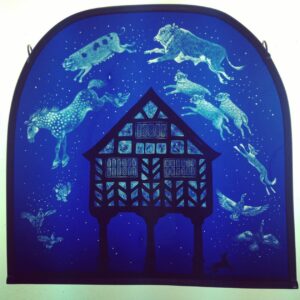
Leslie: What’s special about this medium you’re using?
Tamsin: Glass is alchemical, enchanting, a trickster of light and colour. A piece of stained glass looks different every day depending on the weather, the time of day or year. It goes to sleep at night time unless you are outside looking in, in which case it takes on a new richness, a cluster of jewel-like colour lit up from within against the darkness of outside. Sunlight flooding through glass windows will cast its colours across the room but these colours will never fade with exposure to light only glow.
Leslie: What’s the spiritual context/background to your work?
Tamsin: The spiritual context behind my work is that all life is sacred and deserves to be honoured and revered. I believe that it is the interconnectedness of all things, seen and unseen, that is the most important thing in our lives and that there is a spiritual dimension to this world that lives and breathes through all life, that comes from it, that lingers on after death, that is beyond our understanding. We have a moral purpose to accept our place as part of this intricate and incredible web and to honour and care for all.
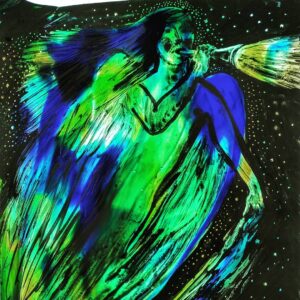
Leslie: With such a complex, laborious physical process to create the finished artwork, how do you ensure your inspiration remains fresh from start to finish?
Tamsin: I think over time one becomes accustomed to the process of whatever it is one does. I used to feel much more frustrated about the way stained glass entails so many processes and takes so long to get from the initial excited inspiration to the final completed work, but I don’t really find it so anymore. But, yes, the drawing of the idea comes first, then the design or cartoon, then the selection of the glass and the cutting, before the joyous part of painting begins. After the painting comes the firing then the laborious processes of leading, soldering, cementing, cleaning and polishing.
I do tend to work on several pieces at a time so that I can spend days at a time on each process such as cutting the glass then the most enjoyable time painting. Because the glass is not really completed until the very final moment when one cleans off the cement then one almost gets that sensation of seeing it for the first time which doesn’t happen with the gradual process of painting on paper or canvas, and that is a real treat.

My sketchbooks are scrappy places divided between rough scrawls of ideas and designs, and detailed drawings of animals, plants, and other items required for that design- I think this is somewhere I need to improve. To find inspiration through the process of drawing would be a wonderful thing.
To be able to work at all it is essential for me to walk in nature, preferably alone. This allows ideas to come in but also the mind to relax and any restlessness to disperse. But the question as to how inspiration remains fresh is a tricky one for all artists. One goes into the workshop or studio every day and each day one is starting afresh. It is sometimes necessary to work without inspiration but if one has a plan or enough unfinished work then activity itself can engender creativity. Picasso himself said ‘Inspiration exists, but it has to find you working.’ I think this is an excellent philosophy whatever one’s creative sphere.
Next week I interview CR Dudley about her independent press Orchid’s Lantern, which specialises in crossovers between the arts.
ABOUT LESLIE TATE’S BOOKS:

I interviewed writer Julia Lee Barclay-Morton about her experience of autism. Julia began as an experimental dramatist in New York, moving to the UK to

I interviewed Gillean McDougall from Glasgow, who edited the collaborative projects Honest Error (on Charles Rennie Mackintosh and his wife Margaret Macdonald) and Writing the

I interviewed French writer Delphine de Vigan, whose book, No et moi, won the prestigious Prix des libraires. Other books of hers have won a clutch

I interviewed Joanne Limburg whose poetry collection Feminismo was shortlisted for the Forward Prize for Best First Collection; another collection, Paraphernalia, was a Poetry Book Society Recommendation. Joanne

I interviewed Katherine Magnoli about The Adventures of KatGirl, her book about a wheelchair heroine, and Katherine’s journey from low self-esteem into authorial/radio success and
| Cookie | Duration | Description |
|---|---|---|
| cookielawinfo-checkbox-analytics | 11 months | This cookie is set by GDPR Cookie Consent plugin. The cookie is used to store the user consent for the cookies in the category "Analytics". |
| cookielawinfo-checkbox-functional | 11 months | The cookie is set by GDPR cookie consent to record the user consent for the cookies in the category "Functional". |
| cookielawinfo-checkbox-necessary | 11 months | This cookie is set by GDPR Cookie Consent plugin. The cookies is used to store the user consent for the cookies in the category "Necessary". |
| cookielawinfo-checkbox-others | 11 months | This cookie is set by GDPR Cookie Consent plugin. The cookie is used to store the user consent for the cookies in the category "Other. |
| cookielawinfo-checkbox-performance | 11 months | This cookie is set by GDPR Cookie Consent plugin. The cookie is used to store the user consent for the cookies in the category "Performance". |
| viewed_cookie_policy | 11 months | The cookie is set by the GDPR Cookie Consent plugin and is used to store whether or not user has consented to the use of cookies. It does not store any personal data. |
3 responses
This is so interesting, Leslie. Lovely to meet Tamsin and learn about her artwork with glass.
Thanks, Robbie. Tamsin’s interview has had more likes and retweets than any other interview I’ve ever put up!
Hello Tamsin
Just watching country file, blown away by your beautiful art work with glass. Do you sell on A website. Or is it all work to order….thank you
Debbie